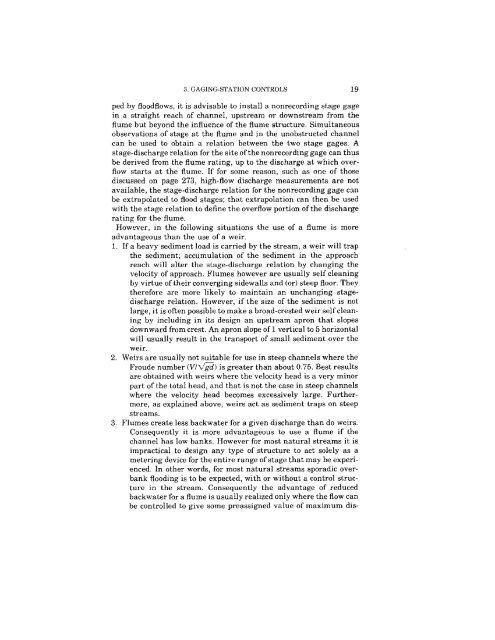PCWA-L 467.pdf - PCWA Middle Fork American River Project ...
PCWA-L 467.pdf - PCWA Middle Fork American River Project ...
PCWA-L 467.pdf - PCWA Middle Fork American River Project ...
You also want an ePaper? Increase the reach of your titles
YUMPU automatically turns print PDFs into web optimized ePapers that Google loves.
3. GAGING·STATION CONTROLS 19<br />
ped by floodflows, it is advisable to install a nonrecording stage gage<br />
in a straight reach of channel, upstream or downstream from the<br />
flume but beyond the influence of the flume structure. Simultaneous<br />
observations of stage at the flume and in the unobstructed channel<br />
can be used to obtain a relation between the two stage gages. A<br />
stage-discharge relation for the site ofthe nonrecording gage can thus<br />
be derived from the flume rating, up to the discharge at which over·<br />
flow starts at the flume. If for some reason, such as one of those<br />
discussed on page 273, high-flow discharge measurements are not<br />
available, the stage-discharge relation for the nonrecording gage can<br />
be extrapolated to flood stages; that extrapolation can then be used<br />
with the stage relation to define the overflow portion ofthe discharge<br />
rating for the flume.<br />
However, in the following situations the use of a flume is more<br />
advantageous than the use of a weir.<br />
1. If a heavy sediment load is carried by the stream, a weir will trap<br />
the sediment; accumulation of the sediment in the approach<br />
reach will alter the stage-discharge relation by changing the<br />
velocity of approach. Flumes however are usually self cleaning<br />
by virtue oftheir converging sidewalls and (or) steep floor. They<br />
therefore are more likely to maintain an unchanging stagedischarge<br />
relation. However, if the size of the sediment is not<br />
large, it is often possible to make a broad-crested weir selfcleaning<br />
by including in its design an upstream apron that slopes<br />
downward from crest. An apron slope of 1 vertical to 5 horizontal<br />
will usually result in the transport of small sediment over the<br />
weir.<br />
2. Weirs are usually not suitable for use in steep channels where the<br />
Froude number (VIVid) is greater than about 0.75. Best results<br />
are obtained with weirs where the velocity head is a very minor<br />
part of the total head, and that is not the case in steep channels<br />
where the velocity head becomes excessively large. Furthermore,<br />
as explained above, weirs act as sediment traps on steep<br />
streams.<br />
3. Flumes create less backwater for a given discharge than do weirs.<br />
Consequently it is more advantageous to use a flume if the<br />
channel has low banks. However for most natural streams it is<br />
impractical to design any type of structure to act solely as a<br />
metering device for the entire range ofstage that may be experienced.<br />
In other words, for most natural streams sporadic overbank<br />
flooding is to be expected, with or without a control structure<br />
in the stream. Consequently the advantage of reduced<br />
backwater for a flume is usually realized only where the flow can<br />
be controlled to give some preassigned value of maximum dis-
















